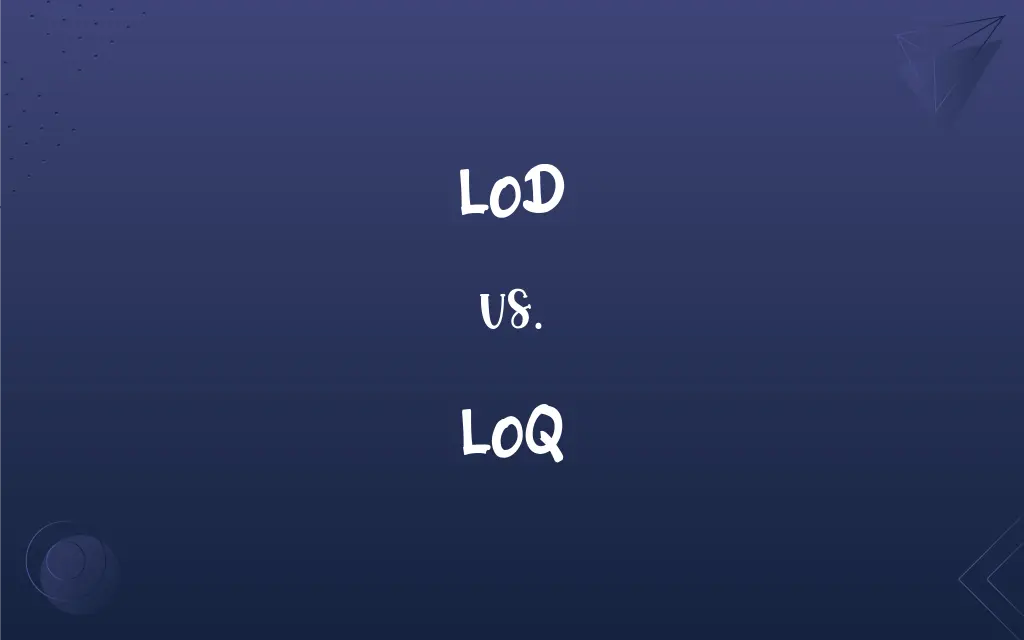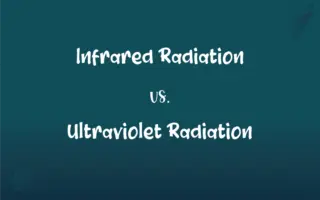LoD vs. LoQ: What's the Difference?
By Harlon Moss & Janet White || Published on August 30, 2024
LoD (Limit of Detection) identifies the smallest amount of a substance detectable by a test, while LoQ (Limit of Quantitation) is the lowest amount that can be quantitatively measured with precision.

Key Differences
The Limit of Detection (LoD) and Limit of Quantitation (LoQ) are critical parameters in analytical chemistry, defining the sensitivity and precision of measurement methods, respectively. LoD refers to the lowest concentration of a substance that can be reliably detected but not necessarily quantified, indicating the presence or absence of the substance. LoQ, on the other hand, represents the minimum concentration at which the substance can not only be detected but also measured with acceptable accuracy and precision, facilitating quantitative analysis.
LoD is pivotal for tests where detecting any amount of a substance is crucial, such as in toxic contaminant or pathogen detection, LoQ is essential for applications requiring accurate quantification, like pharmaceutical quality control and environmental monitoring. The distinction emphasizes the LoD's role in qualitative analysis and the LoQ's importance in quantitative evaluations.
Determining LoD and LoQ involves statistical methods, with LoD often calculated based on the standard deviation of the response and the slope of the calibration curve in a given analytical method. LoQ is typically derived from this by applying a factor that ensures higher confidence in quantification, often requiring a signal-to-noise ratio higher than that for LoD.
The values of LoD and LoQ are not fixed and can vary depending on the analytical technique, the matrix of the sample, and the specific analyte being measured. This variability underscores the importance of optimizing and validating analytical methods for specific applications to achieve reliable detection and quantification limits.
The determination of LoD and LoQ is crucial for compliance with regulatory standards and guidelines in various industries, ensuring that measurements are both sensitive enough to detect harmful levels of substances and accurate enough for meaningful quantification. These parameters help in setting acceptable limits for the presence of various compounds, ensuring product safety and environmental protection.
ADVERTISEMENT
Comparison Chart
Definition
Lowest concentration detectable, not quantifiable
Lowest concentration quantifiably measurable with precision
Purpose
Indicates presence/absence
Allows for accurate quantification
Importance
Critical for detecting minimal traces
Essential for precise measurements
Calculation Method
Based on standard deviation and slope of calibration curve
Derived from LoD with higher statistical confidence
Application
Qualitative analysis, toxic contaminant/pathogen detection
Quantitative analysis, quality control, environmental monitoring
ADVERTISEMENT
LoD and LoQ Definitions
LoD
Reflects test's ability to detect low levels.
A lower LoD means higher sensitivity in detecting contaminants.
LoQ
Indicates level of quantitative reliability.
Pharmaceutical manufacturing uses LoQ to ensure drug potency.
LoD
The minimum amount of substance detectable.
The LoD for lead in water testing indicates the smallest concentration detectable.
LoQ
Requires more substantial evidence for quantification.
LoQ values guide therapeutic drug monitoring for safety and efficacy.
LoD
Used where detection is critical.
LoD values are crucial in early stages of disease diagnosis.
LoQ
Critical for quality control.
In food safety, LoQ ensures contaminants are within acceptable limits.
LoD
Varies with analytical techniques.
LoD for PCR assays is pivotal in identifying minimal viral RNA.
LoQ
Lowest amount quantifiable with precision.
LoQ defines the starting point for accurate pesticide quantification in foods.
LoD
Ensures detection capabilities meet standards.
Environmental monitoring relies on LoD to detect pollutants.
LoQ
Essential for data integrity.
LoQ levels determine the reliability of environmental toxin measurements.
LoD
(statistics) logarithm of odds A measure of likelihood calculated by taking the log of the ratio of the probability of a hypothesis being true given the observed data over the probability that the hypothesis is false.
FAQs
Why is LoD important in analytical testing?
LoD is crucial for identifying the presence of trace amounts of substances, especially in toxicology and pathogen detection.
What does LoD stand for?
LoD stands for Limit of Detection.
Can LoQ be the same as LoD?
No, LoQ is typically higher than LoD as it requires the substance to be measured with acceptable precision and accuracy.
How are LoD and LoQ determined?
They are determined using statistical methods based on the standard deviation of the response and the slope of a calibration curve, among other criteria.
How is LoQ different from LoD?
LoQ (Limit of Quantitation) is the lowest point at which a substance can be quantitatively measured with precision, unlike LoD, which only indicates detectability.
Why is it important to validate LoD and LoQ for each analytical method?
Validation ensures that the method is suitable for its intended purpose, providing confidence in the detection and quantification of analytes.
Are LoD and LoQ relevant in environmental monitoring?
Absolutely, they are key for detecting and quantifying pollutants and ensuring environmental safety.
How do LoD and LoQ affect the interpretation of laboratory results?
They determine the reliability of detecting and quantifying analytes, influencing decision-making in clinical, environmental, and quality control contexts.
In what way do regulatory agencies use LoD and LoQ?
Regulatory agencies set limits based on LoD and LoQ to ensure public health and safety, mandating that these values are met or exceeded in testing.
What role does LoQ play in regulatory compliance?
LoQ ensures that quantitative measurements meet regulatory standards for accuracy and precision in various industries.
What is the significance of signal-to-noise ratio in determining LoD and LoQ?
The signal-to-noise ratio is crucial for distinguishing true signals from background noise, impacting the accuracy of LoD and LoQ determinations.
What challenges are faced in establishing LoQ in complex matrices?
Complex matrices can introduce interferences that affect quantification, requiring sophisticated sample preparation and analytical techniques to establish reliable LoQ values.
Does LoD vary with different analytical methods?
Yes, LoD can vary significantly depending on the sensitivity and specificity of the analytical method used.
How does the matrix of a sample affect LoD and LoQ?
The sample matrix can influence the detectability and quantifiability of substances due to interference, requiring method optimization.
What impact do LoD and LoQ have on clinical diagnostics?
They affect the ability to detect and quantify biomarkers or pathogens, directly influencing diagnosis, treatment decisions, and patient outcomes.
How do LoD and LoQ impact product safety?
They play critical roles in identifying and quantifying harmful substances, ensuring products meet safety standards.
Can LoD and LoQ values change over time for a given method?
Yes, improvements in analytical technology or method optimization can lead to changes in LoD and LoQ values.
How do LoD and LoQ relate to analytical specificity and sensitivity?
LoD is related to sensitivity, indicating the method's ability to detect low concentrations, while LoQ ties into specificity by ensuring accurate quantification.
How do LoD and LoQ contribute to method development in analytical chemistry?
They are key parameters in method development, guiding the selection of appropriate detection and quantification techniques for accurate analysis.
Can LoD and LoQ values be improved? If so, how?
Yes, by optimizing analytical methods, enhancing instrument sensitivity, and using more selective sample preparation techniques, LoD and LoQ values can be improved.
About Author
Written by
Harlon MossHarlon is a seasoned quality moderator and accomplished content writer for Difference Wiki. An alumnus of the prestigious University of California, he earned his degree in Computer Science. Leveraging his academic background, Harlon brings a meticulous and informed perspective to his work, ensuring content accuracy and excellence.
Co-written by
Janet WhiteJanet White has been an esteemed writer and blogger for Difference Wiki. Holding a Master's degree in Science and Medical Journalism from the prestigious Boston University, she has consistently demonstrated her expertise and passion for her field. When she's not immersed in her work, Janet relishes her time exercising, delving into a good book, and cherishing moments with friends and family.







































































